What are GPU and CPU and an introduction to their comparison
Jul. 05, 2025 / Updated by Seraphina to Windows 11
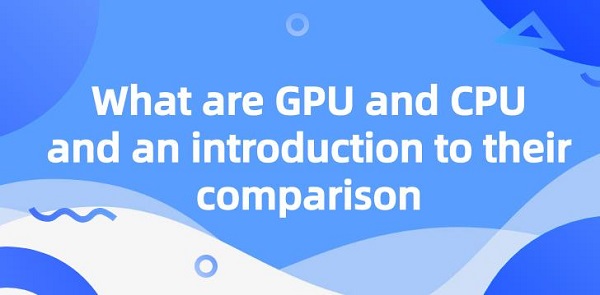
In the hardware composition of computers, graphics cards and central processing units undoubtedly play crucial roles. When we mention graphics cards and central processing units, their professional terms—GPU & CPU are often mentioned as well. So, what are the similarities and differences between GPU and CPU? This article will provide a detailed introduction and comparison of CPU and GPU from four aspects: concepts, functionalities, updates, and distinctions.
Contents:
1). CPU (Central Processing Unit)
2). GPU (Graphics Processing Unit)
2. Introduction of GPU and CPU Functionalities
4. The heterogeneity of GPU and CPU
1). CPU (Central Processing Unit):
The CPU is the central processor in a computer system, responsible for executing various instructions and controlling the operation of the computer. It usually consists of several large, complex cores, each capable of executing multiple threads to handle various types of tasks. CPUs primarily handle general computing tasks such as arithmetic operations, logic operations, and control flow. CPUs are better suited for handling serial tasks, executing instructions sequentially, and performing well in tasks involving complex logic and control flow.
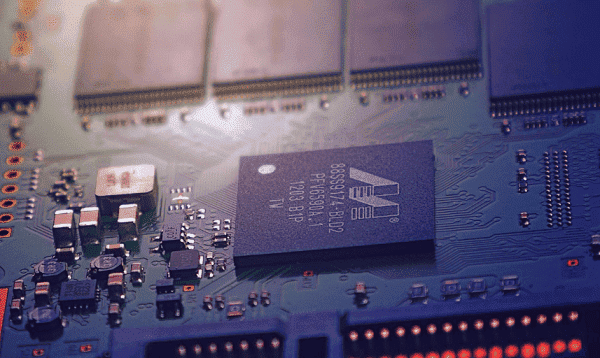
2). GPU (Graphics Processing Unit):
The GPU is a processor specifically designed to handle graphics and image-related computing tasks. It typically has numerous small processing units called stream processors or CUDA cores, designed for parallel processing tasks. GPU functionalities include graphics rendering, image processing, video decoding, parallel computing, etc. GPUs are designed for parallel processing tasks due to their large number of processing units, allowing them to execute multiple tasks simultaneously. GPUs excel in tasks requiring intensive computation in graphics, images, and are widely used in scientific computing, deep learning, among other fields.
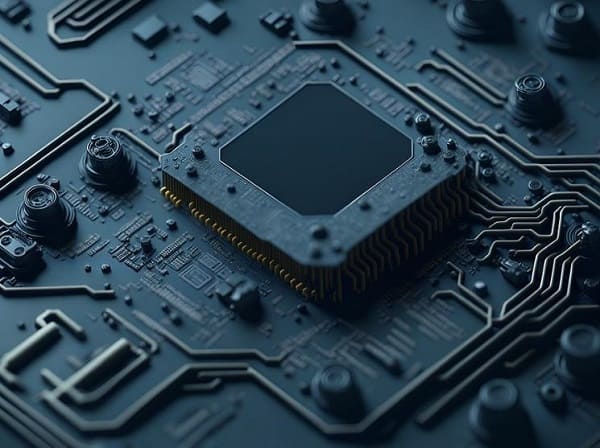
2. Introduction of GPU and CPU Functionalities:
(1). Graphics Rendering:
One of the main functions of a GPU is graphics rendering. It converts elements such as models, textures, lighting, etc., in a 3D scene into a 2D image displayed on the monitor. GPUs achieve this by executing various graphics rendering algorithms and stages in the graphics pipeline, such as vertex shaders, pixel shaders, etc.
(2). Image Processing:
GPUs have rich image processing capabilities, allowing various operations on images, including filters, effects, image restoration, image enhancement, etc. These functionalities are widely used in applications such as photo editing software, video editing software, etc.
(3). Video Decoding and Encoding:
Modern GPUs also have functionalities for video decoding and encoding, capable of decoding (e.g., decompression, decryption) and encoding (e.g., compression, encryption) video streams to achieve high-definition video playback and video streaming.
(4). Parallel Computing:
With a large number of processing units (such as CUDA cores or stream processors), GPUs are well-suited for parallel computing tasks. In addition to graphics-related tasks, GPUs can be used for general-purpose parallel computing (GPGPU), such as scientific computing, deep learning, cryptography, etc.
(5). Virtual Reality (VR) and Augmented Reality (AR):
Due to their powerful graphics processing and parallel computing capabilities, GPUs play a crucial role in virtual reality and augmented reality applications. They can render complex virtual scenes in real-time and provide smooth interactive experiences.
(6). Machine Learning and Artificial Intelligence:
The parallel computing capabilities of GPUs make them important tools in the fields of machine learning and artificial intelligence. Many deep learning algorithms and neural network models can be accelerated for training and inference using GPUs, improving efficiency and performance.
(1). Instruction Execution:
The CPU is responsible for executing instructions in computer programs, including arithmetic operations, logic operations, data transfer, control flow, etc. It sequentially executes operations based on the instruction sequence in the program to accomplish various tasks.
(2). Controlling Computer Operation:
As the core of the computer system, the CPU controls and coordinates the operation of various components of the computer system. It synchronizes the operations of various components based on clock signals and schedules and executes instructions based on the program's requirements.
(3). Cache Management:
The CPU typically contains multiple levels of cache for temporarily storing data and instructions to accelerate data access and improve program execution efficiency. The CPU manages cache read and write operations to ensure data consistency and correctness.
(4). Exception Handling and Interrupt Handling:
The CPU can detect and handle various exceptional conditions and interrupt requests, such as program errors, hardware faults, external device requests, etc. It promptly responds to and processes these exceptions to ensure the stable operation of the computer system.
(5). Multitasking:
Modern operating systems allow computers to run multiple programs simultaneously, and the CPU is responsible for switching and scheduling between these programs to share CPU time and memory space under limited resources.
(6). Floating-Point Arithmetic:
CPUs typically contain dedicated floating-point units for executing floating-point arithmetic operations, such as addition, subtraction, multiplication, division, square root, trigonometric functions, etc. These operations are essential for scientific computing, engineering calculations, and graphics processing.
(7). Power Saving and Dynamic Frequency Adjustment:
To save energy and reduce power consumption, modern CPUs usually have power-saving features and dynamic frequency adjustment capabilities. They dynamically adjust the operating frequency and voltage based on system load and performance requirements to achieve the optimal balance of performance and energy efficiency.
Graphics card drivers serve as a bridge between the graphics card and the operating system, responsible for fully utilizing the graphics card's functions and performance. However, as operating systems and applications are continuously updated, graphics card drivers may become incompatible or outdated. Therefore, regularly updating graphics card drivers is crucial, and you can automatically identify and update them through Driver Talent.
Open Driver Talent and click "Scan".
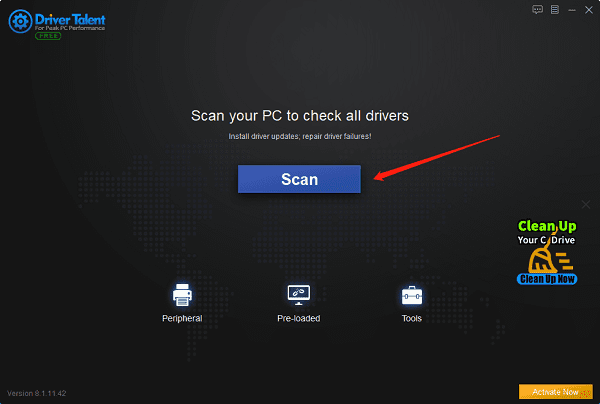
If it shows that there is a new version of your graphics card driver pending an update, click "Download".
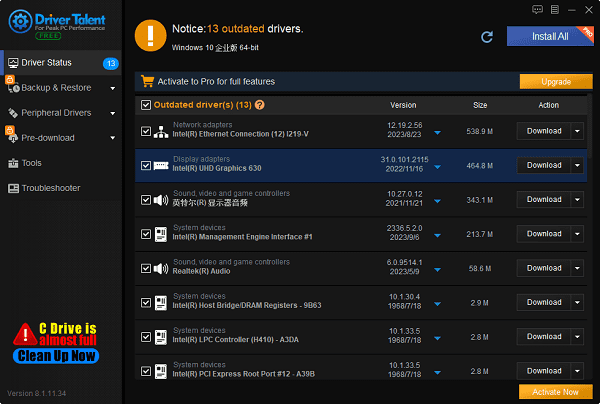
Wait for the upgrade to succeed, restart your computer to ensure that the new version of the graphics card driver takes effect normally.
Of course, you can also download the latest drivers from official websites such as GPU manufacturers (NVIDIA or AMD) or computer manufacturers' official websites and update them through the installer.
2). CPU Update:
CPU updates typically require replacing the entire processor, which may require replacing the entire motherboard or upgrading the CPU socket. Such updates generally require more hardware operations and may require reinstalling or updating related drivers in the operating system.
For desktop computers and laptops, you need to ensure that the new CPU is compatible with the motherboard and follow the manufacturer's guidelines for updating.
4. The heterogeneity of GPU and CPU:
Processor: Both CPU and GPU are processors used for computing and processing tasks.
Memory Access: Both CPU and GPU can access memory and other storage devices to retrieve data and instructions.
Parallelism: Although to varying degrees, both CPU and GPU can execute multiple tasks or instructions in parallel.
Design Purpose: CPUs are designed for general computing tasks such as arithmetic operations, logic operations, and system control. GPUs are specifically designed for graphics and image processing tasks such as graphics rendering, image processing, video decoding, etc.
Processing Units: CPUs typically contain several complex cores, each capable of handling multiple threads. GPUs have a large number of small processing units (such as CUDA cores or stream processors) designed for parallel processing of large numbers of similar computing tasks.
Computing Capability: GPUs excel in parallel computing, especially in handling large-scale data and compute-intensive tasks. CPUs are more suitable for handling serial tasks and complex logic.
Hardware Structure: CPUs are designed with a focus on control flow and general computing capabilities, thus having a more complex hardware structure and higher clock frequencies. GPUs are designed with a focus on parallel computing and graphics processing performance, thus having a large number of simple processing units and lower clock frequencies.
Optimized Algorithms: Due to different design goals, CPUs and GPUs typically use different optimization algorithms and instruction sets to maximize their respective performance advantages.
The above is an introduction and comparison of GPU and CPU, including their concepts, functionalities, updates, and distinctions. If you encounter issues related to drivers such as network cards, graphics cards, Bluetooth, sound cards, etc., you can use "Driver Talent" to detect and repair them. Additionally, Driver Talent supports driver downloads, installations, backups, etc., providing flexible driver management solutions.
See also:
How to install sound card drivers
Steps to clean up a full C drive on the computer
Dota 2 crash troubleshooting guide
No Internet Connection-5 Common Solutions
Is Cyberpunk 2077 still a good game and it's crash troubleshooting guide

|
ExplorerMax |

|
Driver Talent for Network Card | |
| Smart and advanced file explorer tool for Windows platforms | Download & Install Network Drivers without Internet Connection | |||
| 30-day Free Trial | Free Download |







